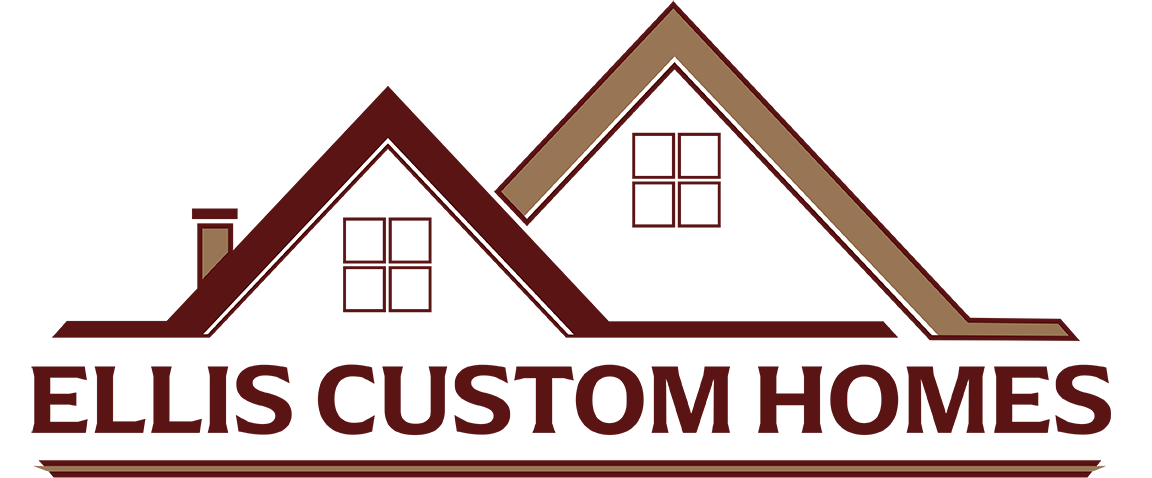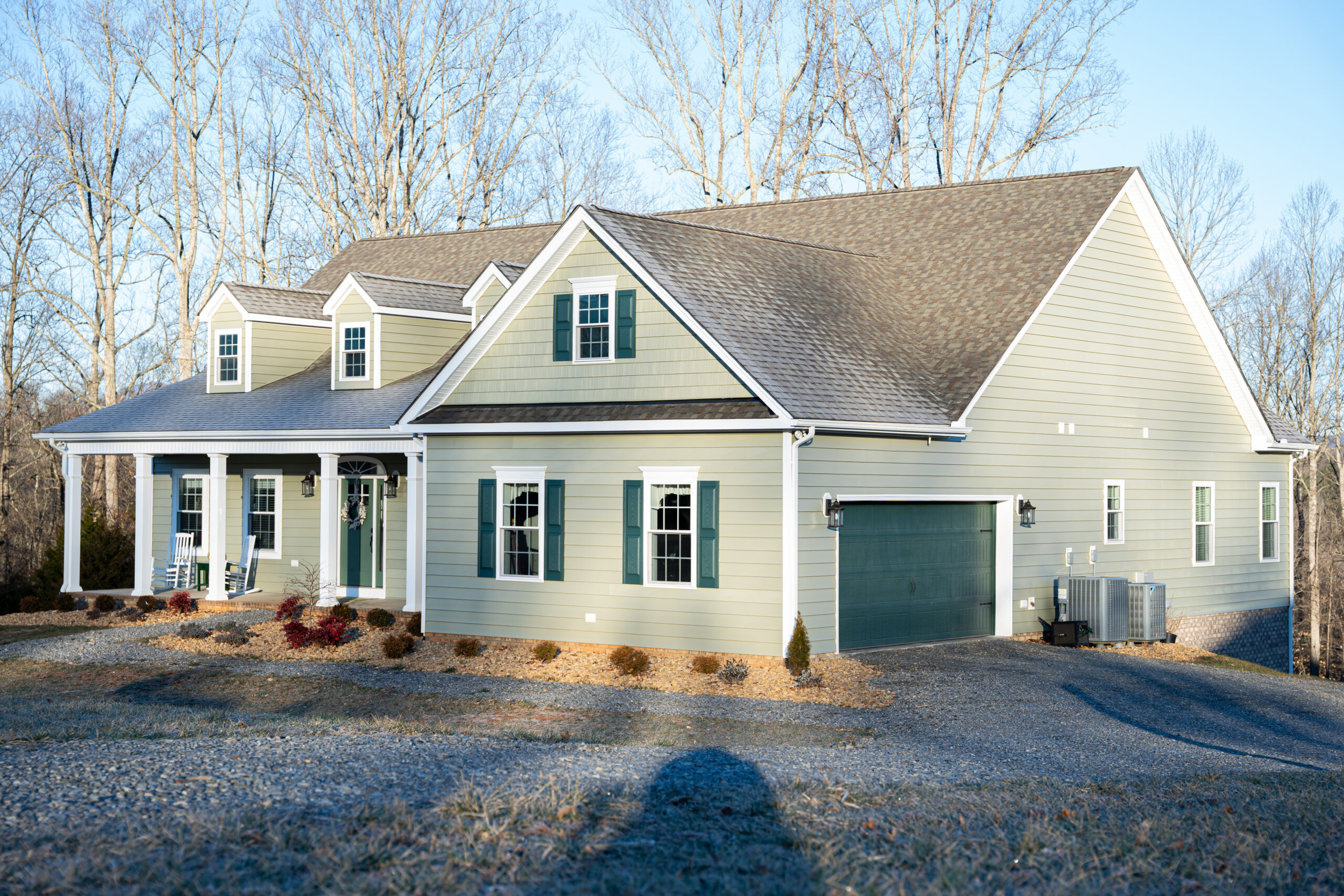When it comes to your home’s exterior, the choices you make today will impact curb appeal, maintenance, and value for decades to come. Understanding the real differences between siding options helps you make informed decisions that align with your priorities and lifestyle.
Vinyl Siding: Why Thickness Matters
Not all vinyl siding is created equal. While many builders default to thin, builder-grade vinyl siding (typically .035″-.040″ thick), quality builders specify premium options with thicker gauges. According to the American Society for Testing and Materials (ASTM D3679), vinyl siding must meet minimum thickness requirements of .035″.
At Ellis Custom Homes, we use Mastic CarvedWood•44 at .044″ gauge as our standard—well above minimum requirements. This premium product from Mastic (part of the Ply Gem portfolio) delivers exceptional performance through its carefully engineered specifications.
Why We Choose Mastic CarvedWood•44
Superior Engineering Features:
- Premium .044″ Thickness: 25% thicker than builder-grade options for superior rigidity and impact resistance
- Enhanced Shadow Lines: Full 5/8″ lap projection creates deep, authentic wood-grain appearance
- Wind Resistance: Rated for winds up to 153 mph (Standard DP of 56 PSF)
- Color Technology: Rich color throughout the panel virtually eliminates appearance of nicks and scratches
- Locking System: Wider mechanism provides more contact area for secure, precise installation
The SolarDefense Advantage
Nine CarvedWood•44 colors feature Mastic’s exclusive SolarDefense Reflective Technology™, which protects darker colors from UV damage. This technology comes with an industry-leading “No Fade, No Distortion Promise”—allowing homeowners to choose deep, rich colors without worrying about warping or fading.
See How Thickness Affects Quality
The Mastic V.I.P. Limited Lifetime Warranty
Our choice of Mastic CarvedWood•44 is backed by one of the industry’s strongest warranties—the V.I.P. Limited Lifetime Warranty. This comprehensive coverage is fully transferable to subsequent homeowners, adding value to your investment. Mastic’s 80+ year legacy in home exteriors stands behind every panel we install.
The difference between .035″ and .044″ is just .009″ (less than three business cards), but this 25% increase in thickness delivers significantly better performance, allowing for deeper shadow lines, better wind resistance, and the ability to produce deep, dark colors without warping.
Installation: The Invisible Deal-Breaker
Even the best siding fails with poor installation. The difference between professional installation and a rushed job becomes obvious after just a few years.
Critical Installation Details
- Proper nailing patterns that allow for expansion and contraction
- Correct overlap and gap specifications
- Professional handling of corners and trim interfaces
- Meticulous flashing around windows and doors
- Crews that follow manufacturer specifications
LP SmartSide vs. James Hardie
In neighborhoods where vinyl isn’t permitted, LP SmartSide and James Hardie fiber-cement become the primary options. According to manufacturer specifications, here’s how they compare:
| Feature | LP SmartSide | James Hardie |
|---|---|---|
| Weight | 1/3 lighter, easier install | Heavy, requires more crew |
| Cutting | Standard blades, no dust | Special tools, silica dust |
| Warranty | 50-year (5-year full, then prorated) | 30-year non-prorated |
| Flexibility | Resists cracking | Rigid, can crack |
| Priming | All 6 sides factory-primed | Field cuts need priming |
| Pricing** | 50-100% more than vinyl | 60-120% more than vinyl |
**Pricing varies significantly by region, project complexity, and installer. These are general ranges compared to premium vinyl siding.
Moisture Management: The Hidden Critical Factor
Behind every siding job is a moisture management system that determines whether your walls stay dry for decades. More siding failures result from water infiltration than from the siding material itself.
What Quality Builders Include:
- Proper water-resistive barriers (Ellis Custom Homes uses ZIP System® sheathing)
- Complete flashing at all penetrations
- Drainage gaps behind siding
- Careful sealing where materials meet
- Foundation protection (including waterproofing and drainage systems)
The Evolution Away from Brick
While brick remains a quality material, market data shows changing preferences in new construction. According to the Census Bureau’s Characteristics of New Housing, vinyl siding leads at approximately 26% of new homes, with fiber cement at 21%, and brick/stone declining to around 20%. This shift reflects evolving priorities:
- Design Flexibility: Painted siding allows color updates every 10-15 years
- Cost Considerations: Similar price to premium siding without flexibility
- Architectural Trends: Modern styles favor clean lines and mixed materials
- Maintenance Reality: Repointing, efflorescence cleaning, crack repair needed
- Labor Market: Skilled masonry contractors becoming less available in many areas
Where Brick Still Makes Sense
- Accent wainscoting on front elevations
- Columns and architectural features
- Foundation-level applications
- Mixed with siding for visual interest
Maintenance Expectations
No siding is truly maintenance-free forever. Premium products simply extend the time between maintenance and look better longer. These are general guidelines—actual maintenance schedules vary based on climate conditions, installation quality, and exposure:
Premium Vinyl (.044″+) – Mastic CarvedWood•44
Typically requires washing every 2-3 years. May need individual panel replacement after severe storms. The V.I.P. Limited Lifetime Warranty covers manufacturing defects. Expected lifespan: 30-50+ years depending on installation quality and conditions.
LP SmartSide or Hardie
Generally requires repainting every 10-15 years in our climate. Re-caulking needed as materials age. Field cuts require special attention. Expected lifespan: 30-50+ years with proper maintenance.
Brick
Repointing mortar joints typically needed every 20-30 years. Efflorescence cleaning as needed. Crack repairs vary by settling. Can last 100+ years with proper maintenance.
Energy Efficiency Considerations
While siding primarily protects your home’s structure, it also impacts energy efficiency. Here’s how different materials compare:
Insulated Vinyl Siding
Can increase R-value by 2.0-5.0 when foam backing is added. Studies show potential energy savings of 10-20% compared to non-insulated options.
Fiber Cement (Hardie/LP SmartSide)
Minimal inherent insulation value (R-value approximately 0.50). Requires proper installation with house wrap and air gaps for best thermal performance.
Brick
Provides thermal mass but limited insulation (R-value around 0.80). Benefits from its ability to absorb and slowly release heat.
Environmental Impact & Sustainability
Increasingly, homeowners consider environmental factors when choosing siding:
Vinyl Siding
Made from PVC, which has improved manufacturing processes in recent years. Can be recycled through specialized programs—ask your installer about recycling old vinyl siding. Lifespan of 30-50 years means less frequent replacement.
LP SmartSide
Made from engineered wood products using fast-growing trees and wood strands. Uses zinc borate treatment instead of more toxic preservatives. Renewable resource, though requires repainting over its lifetime.
James Hardie
Contains sand, cement, and cellulose fibers. Manufacturing is energy-intensive but the 50+ year lifespan offsets initial impact. Non-combustible nature can reduce fire spread in communities.
Brick
Extremely durable (100+ year lifespan) but energy-intensive to manufacture. Can often be reclaimed and reused. Natural clay material returns to earth without toxicity.
Virginia Climate Considerations
Our hot, humid climate brings unique challenges that make proper material selection and installation critical. This is precisely why Ellis Custom Homes standardizes on Mastic CarvedWood•44:
- UV Protection: SolarDefense technology prevents fading on south/west walls
- Wind Resistance: 153 mph rating exceeds Virginia’s storm requirements
- Moisture Resistance: Engineered formulation resists warping in high humidity
- Temperature Stability: .044″ thickness handles expansion/contraction without buckling
- Impact Resistance: Superior thickness protects against hail and debris
Mastic’s exclusive formulation and manufacturing process creates panels that are specifically engineered to handle temperature extremes and humidity—critical factors in Virginia’s climate where summer temperatures can exceed 95°F with high humidity, while winter can bring freezing conditions.
Making Your Decision
If You Want Best Value
Premium vinyl (.044″ minimum) offers the best balance of appearance, durability, and maintenance. Ellis Custom Homes’ standard—Mastic CarvedWood•44—represents this premium category, providing peace of mind through superior engineering and comprehensive warranty protection.
If Vinyl Isn’t Allowed
LP SmartSide edges out Hardie for most homeowners. Better warranty terms, easier installation, more flexibility. Just plan for repainting every 10-15 years.
If Comparing Builders
Focus on specific product names and thicknesses, not vague specifications. Quality builders like Ellis Custom Homes will proudly share exact products (like Mastic CarvedWood•44) and explain why they chose them. Ask about:
- Exact siding thickness and brand specifications
- Wind resistance ratings for your area
- Warranty details and transferability
- Installation crew certification and experience
- Complete moisture management systems
- Vague specs using “or equivalent” without defining standards
- Reluctance to put specific product names and thicknesses in writing
- Only showing brand-new homes or renderings
- Unable to explain their moisture management approach
- No clear warranty on workmanship
The Bottom Line
Your home’s exterior is your first defense against weather, your biggest maintenance factor, and a major component of value. Focus on thickness for vinyl (minimum .044″), understand real costs including trim, and ensure your builder knows how to keep water out.
View Our Complete SpecificationsAdditional Resources
- ASTM D3679 – Standard Specification for Rigid Poly(Vinyl Chloride) (PVC) Siding: astm.org/d3679-17.html
- Vinyl Siding Institute: vinylsiding.org
- Mastic by Ply Gem: plygem.com/mastic
- LP Building Solutions: lpcorp.com
- James Hardie Building Products: jameshardie.com
- U.S. Census Bureau – Characteristics of New Housing: census.gov/construction/chars
Additional Articles
Granite Countertops: What You Need to Know Before Building Your Home
We includes granite countertops as standard in all homes we build because they deliver lasting beauty and performance. Learn why granite outperforms other materials and what to look for in quality fabrication and installation.
Read more
